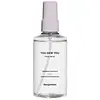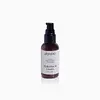What's inside
What's inside
 Key Ingredients
Key Ingredients

 Benefits
Benefits

 Concerns
Concerns

 Ingredients Side-by-side
Ingredients Side-by-side

Water
Skin ConditioningGlycerin
HumectantPropanediol
SolventSodium Hyaluronate
HumectantRubus Idaeus Fruit Extract
AstringentPyrus Malus Fruit Extract
Skin ConditioningPEG-40 Hydrogenated Castor Oil
EmulsifyingPrunus Persica Leaf Extract
EmollientSaccharide Isomerate
HumectantSaccharomyces/Xylinum/Black Tea Ferment
Skin ConditioningSodium PCA
HumectantParfum
MaskingEthylhexylglycerin
Skin ConditioningAloe Barbadensis Leaf Powder
Skin ConditioningPhenoxyethanol
PreservativePropylene Glycol
HumectantTrideceth-9
EmulsifyingCitric Acid
BufferingSodium Citrate
BufferingPotassium Sorbate
PreservativeSodium Benzoate
MaskingAscorbic Acid
AntioxidantWater, Glycerin, Propanediol, Sodium Hyaluronate, Rubus Idaeus Fruit Extract, Pyrus Malus Fruit Extract, PEG-40 Hydrogenated Castor Oil, Prunus Persica Leaf Extract, Saccharide Isomerate, Saccharomyces/Xylinum/Black Tea Ferment, Sodium PCA, Parfum, Ethylhexylglycerin, Aloe Barbadensis Leaf Powder, Phenoxyethanol, Propylene Glycol, Trideceth-9, Citric Acid, Sodium Citrate, Potassium Sorbate, Sodium Benzoate, Ascorbic Acid
Water
Skin ConditioningPropanediol
SolventUrea
BufferingCaprylic/Capric Triglyceride
MaskingSodium PCA
HumectantSodium Benzoate
MaskingPotassium Sorbate
PreservativeSodium Hyaluronate
HumectantPanthenol
Skin ConditioningHydroxyethylcellulose
Emulsion StabilisingHyaluronic Acid
HumectantAloe Barbadensis Leaf Powder
Skin ConditioningCitric Acid
BufferingAllantoin
Skin ConditioningPorphyra Umbilicalis Extract
Skin ConditioningChamomilla Recutita Extract
Skin ConditioningUsnea Barbata Extract
Cucumis Sativus Fruit Extract
EmollientWater, Propanediol, Urea, Caprylic/Capric Triglyceride, Sodium PCA, Sodium Benzoate, Potassium Sorbate, Sodium Hyaluronate, Panthenol, Hydroxyethylcellulose, Hyaluronic Acid, Aloe Barbadensis Leaf Powder, Citric Acid, Allantoin, Porphyra Umbilicalis Extract, Chamomilla Recutita Extract, Usnea Barbata Extract, Cucumis Sativus Fruit Extract
 Reviews
Reviews

Ingredients Explained
These ingredients are found in both products.
Ingredients higher up in an ingredient list are typically present in a larger amount.
Aloe Barbadensis Leaf Powder comes from the aloe plant.
Aloe leaves have a variety of benefits. They are most commonly known for the ability to soothe sunburns. This is due to their anti-inflammation and cooling properties.
Aloe leaves also contain many vitamins, such as Vitamins A, C, and E. These vitamins are all antioxidants that can reduce skin damage from free-radical molecules.
Aloe should not replace your sunscreen as it does not protect against UV.
Learn more about Aloe Barbadensis Leaf PowderCitric Acid is an alpha hydroxy acid (AHA) naturally found in citrus fruits like oranges, lemons, and limes.
Like other AHAs, citric acid can exfoliate skin by breaking down the bonds that hold dead skin cells together. This helps reveal smoother and brighter skin underneath.
However, this exfoliating effect only happens at high concentrations (20%) which can be hard to find in cosmetic products.
Due to this, citric acid is usually included in small amounts as a pH adjuster. This helps keep products slightly more acidic and compatible with skin's natural pH.
In skincare formulas, citric acid can:
While it can provide some skin benefits, research shows lactic acid and glycolic acid are generally more effective and less irritating exfoliants.
Most citric acid used in skincare today is made by fermenting sugars (usually from molasses). This synthetic version is identical to the natural citrus form but easier to stabilize and use in formulations.
Read more about some other popular AHA's here:
Learn more about Citric AcidPotassium Sorbate is a preservative used to prevent yeast and mold in products. It is commonly found in both cosmetic and food products.
This ingredient comes from potassium salt derived from sorbic acid. Sorbic acid is a natural antibiotic and effective against fungus.
Both potassium sorbate and sorbic acid can be found in baked goods, cheeses, dried meats, dried fruit, ice cream, pickles, wine, yogurt, and more.
You'll often find this ingredient used with other preservatives.
Learn more about Potassium SorbatePropanediol is an all-star ingredient. It softens, hydrates, and smooths the skin.
It’s often used to:
Propanediol is not likely to cause sensitivity and considered safe to use. It is derived from corn or petroleum with a clear color and no scent.
Learn more about PropanediolSodium Benzoate is a preservative. It's used in both cosmetic and food products to inhibit the growth of mold and bacteria. It is typically produced synthetically.
Both the US FDA and EU Health Committee have approved the use of sodium benzoate. In the US, levels of 0.1% (of the total product) are allowed.
Sodium benzoate works as a preservative by inhibiting the growth of bacteria inside of cells. It prevents the cell from fermenting a type of sugar using an enzyme called phosphofructokinase.
It is the salt of benzoic acid. Foods containing sodium benzoate include soda, salad dressings, condiments, fruit juices, wines, and snack foods.
Studies for using ascorbic acid and sodium benzoate in cosmetics are lacking, especially in skincare routines with multiple steps.
We always recommend speaking with a professional, such as a dermatologist, if you have any concerns.
Learn more about Sodium BenzoateSodium Hyaluronate is hyaluronic acid's salt form. It is commonly derived from the sodium salt of hyaluronic acid.
Like hyaluronic acid, it is great at holding water and acts as a humectant. This makes it a great skin hydrating ingredient.
Sodium Hyaluronate is naturally occurring in our bodies and is mostly found in eye fluid and joints.
These are some other common types of Hyaluronic Acid:
Learn more about Sodium HyaluronateSodium PCA is the sodium salt of pyroglutamic acid. It is naturally occurring in our skin's natural moisturizing factors where it works to maintain hydration.
The PCA stands for pyrrolidone carboxylic acid, a natural amino acid derivative.
This ingredient has skin conditioning, anti-inflammatory, and humectant properties. Humectants help hydrate your skin by drawing moisture from the air. This helps keep your skin moisturized.
Learn more about Sodium PCAWater. It's the most common cosmetic ingredient of all. You'll usually see it at the top of ingredient lists, meaning that it makes up the largest part of the product.
So why is it so popular? Water most often acts as a solvent - this means that it helps dissolve other ingredients into the formulation.
You'll also recognize water as that liquid we all need to stay alive. If you see this, drink a glass of water. Stay hydrated!
Learn more about Water